The killings of nine Emanuel African Methodist Episcopal Church members in Charleston, South Carolina, have ignited a cultural clash over the symbolic nature of the Confederate Flag, of which shooter Dylann Roof proudly raised in pictures taken before the murders. Scores of written, aural, and visual news stories subsequently have been produced to identify the true contextual origins of the Confederate flag, highlighting the argument that the flag is either a reverent symbol honoring Confederate soldiers or an insignia of racist hatred toward African-Americans. This essay will briefly trace the intersection of Confederate iconography and Southern college football, two undoubtedly brash southern signifiers that form a microcosm of the heritage or hate argument.
On June 23, 2015, Steve Spurrier, the head football coach of the University of South Carolina Gamecocks, tweeted his support for the removal of the Confederate flag.
The South Carolina football team, players and coaches strongly support Governor Haley’s decision to remove the flag from the capitol.
— Coach Steve Spurrier (@SC_HBC) June 23, 2015
The “Head Ball Coach”, who played high school football in Tennessee and won the coveted Heisman Trophy as the quarterback of the University of Florida Gators’ 1966 team, previously voiced his opposition to the flag at a 2007 awards benefit. Spurrier was frustrated that “some clown” displayed the “damn Confederate flag” in the background of the ESPN College GameDay pre game show. “I realize I’m not supposed to get in the political arena as a football coach, but if anybody were ever to ask me about that damn Confederate flag, I would say we need to get rid of it,” he said. “I’ve been told not to talk about that. But if anyone were ever to ask me about it, I certainly wish we could get rid of it.” Spurrier’s political commentary should not be undervalued and was a controversial statement, as evidenced by the death threats he received from some lunatic fans who felt Confederate roots and their football team were inseparable. A deep history regarding the conflation of the Confederacy and college football is traced back to 19th Century, when white southerners strived to regain control of the region following Reconstruction. (See “Spurrier: Flag should come down from S.C. Statehouse” ESPN.com April 16, 2007, http://sports.espn.go.com/ncf/news/story?id=2837735)
Southern college football teams have honored their Confederate heritage with nicknames, uniforms, and rituals. According to historian Patrick Miller, Louisiana State University chose the nickname “Fighting Tigers” to commemorate the distinguished fighting units known as the New Orleans Zouaves and Donaldsville Cannoneers. The University of Virginia, although currently a member of the Atlantic Coast Conference (ACC) and not particularly associated with modern-day SEC football powerhouses, paid homage to the Confederacy with their uniforms. Miller wrote the colors “[s]ilver gray and cardinal red were interned to represent the glory of the Confederacy, dyed in the blood of the fallen.” (See Patrick B. Miller, “The Manly, the Moral, and the Proficient: College Sport in the New South,” in The Sporting World of the Modern South, ed. by Patrick B. Miller, (Urbana: University of Illinois Press, 2002), 30-32.)
Confederate analogies, metaphors, and commemoration escalated after the University of Alabama defeated the University of Washington in the 1926 Rose Bowl. The Atlanta Georgian labeled the 1926 Rose Bowl victory as “the greatest victory for the South since the first battle of Bull Run.” The Atlanta Journal argued the football team belonged in the pantheon of Confederate leaders Jefferson Davis, Robert E. Lee, and Stonewall Jackson: “The Crimson Tide no longer belongs exclusively to Tuscaloosa and the state of Alabama. It belongs to the whole South just like the Stone Mountain Memorial.” In addition, after the Alabama Crimson Tide returned to the Rose Bowl in 1927, the marching band performed the song “Dixie” as the players stormed the field. (See Andrew Doyle, “Turning the Tide: College Football and Southern Progressivism, in The Sporting World of the Modern South, ed. by Patrick B. Miller, (Urbana: University of Illinois Press, 2002),110-111.)
Christopher C. Nehls essay, “Flag-Waving Wahoos. Confederate Symbols at the University of Virginia, 1941-51,” chronicles the ubiquity of Confederate memorabilia at football games. Nehls argues that “[t]he young men of Charlottesville flew their flags as a symbol of their segregated world while allowing the flag to stand for broader cultural issues facing the university as an institution, the South as a region, and even the nation in times of war and cultural homogenization.” In a 1941 game against Yale, College Topics reported “a thousand hands” lifted the Confederate battle flag and fans from both teams sang “Dixie” at halftime to mark the first documented example of Confederate recognition at a Virginia football game. “Dixie” was also played in 1947 when an African-American tackle from Harvard, Chester Pierce, broke the southern color line in a home game at Charlottesville. Surprisingly, there is no known evidence of dirty play on the field toward Pierce, but a writer from the Richmond Afro-American reported Pierce’s reception “was paradoxical in view of the sporting of Rebel flags and the band’s persistent blaring of ‘Dixie.’” The flying of the Confederate flag ceased as the football team’s on field performance dwindled. Ultimately, Nehls concludes that “[u]nlike at Deep South institutions, the flag at Virginia was not rigidly tied to a segregationist message, although could easily accommodate one.” (See Christopher C. Nehls, “Flag-Waving Wahoos. Confederate Symbols at the University of Virginia, 1941-51,” The Virginia Magazine of History and Biography, Vol. 110, No 4 (2002):469, 482-483.)
Derrick E. White documents the racial connotations of the Confederate flag and football in “From Desegregation to Integration: Race, Football, and ‘Dixie’ at the University of Florida”. The University of Florida unequivocally used Confederate iconography to uphold white supremacy in the 1962 Gator Bowl against Penn State University, with the African-American standout David Robinson. According to White, “Head coach Ray Graves saw an opportunity to gain a psychological and emotional advantage over Penn State and its leading receiver Dave Robinson. He ordered a Confederate Battle Flag patch seen on the team uniforms and replaced the Gators’ traditional block numbers on the helmets with a Confederate flag.” As the Gators ran onto the field, the marching band played Dixie and Confederate flags waved throughout the stadium. Then following a 17-7 Gators victory, Coach Graves told reporters the team was committed to “upholding the honor of southern football.” (See Derrick E. White, “From Desegregation to Integration: Race, Football, and ‘Dixie’ at the University of Florida” Florida Historical Quarterly, Vol. 88, No. 4 (Spring 2010), 40-472.)
Derrick White’s article also analyzed the problematic nature of white supremacy related rituals—waving the Confederate flag and the singing of “Dixie”—as African American students enrolled at the University of Florida for the first time in 1962. At the heart of southern college football pageantry was the song “Dixie,” written by the white minstrel performer Daniel Decatur Emmett in 1859. According to White, minstrelsy “was designed to dehumanize blacks, justify antebellum slavery, and negate the idea of black equality after the Civil War.” The song’s pervasiveness throughout all-white southern universities suggests at best ignorant racial insensitivity and at worst the glorification of white supremacy. As noted above, “Dixie” was a fixture at the 1927 Rose Bowl game and at the University of Virginia’s football contests in the 1940s. In addition, the University of Georgia’s band was referred to as “Dixie Redcoat Band” and The Citadel’s band performed “Dixie” against Army in 1968. Moreover, an Alabama statute required the University of Alabama band to perform “Dixie”— as well as fly the Confederate flag at the football games—in response to the Civil Rights push for integration. Florida discontinued “Dixie” at football games in 1973 and the University of Georgia followed in 1975, but “Dixie” was performed at the University of Mississippi football games well into the 2000s. (See White, 474-477)
Joshua Newman’s “Army of Whiteness? Colonel Reb and the Sporting South’s cultural and corporate symbolic” traces the long history of Confederate iconography at the University of Mississippi. Confederate symbolism increased in 1948, when the Dixiecrats, who walked out of the 1948 Democratic National Convention in protest of integrationist policies, incorporated the Confederate flag and “Dixie” as symbols for a segregationist platform. According to Newman, “[t]o rally support on the Ole Miss campus, the Dixiecrats passed out small Confederate flags during home football games.” A large 60-by-90 foot Confederate flag was held at midfield during the halftime homecoming celebration. Furthermore, the school band, in Confederate grey uniforms, performed “Dixie” to the delight of Rebels fans. (See Joshua Neman, “Army of Whiteness? Colonel Reb and the Sporting South’s cultural and corporate symbolic. Journal of Sport and Social Issues, 31(4), 2007, 320; and Nehls, 480)
Another controversial Confederate signifier at the University of Mississippi is the mascot Colonel Reb, which became part of the university in 1936 after students tired of the nickname “The Red and Blue” and voted “Rebels” as its replacement. According to Newman, the early version of Col. Reb resembled an aristocratic plantation owner and it was not until 1948 when Col. Reb was associated with the Confederacy, as a student would dress up as a soldier and lead cheers. Newman argues the Confederate image was a “political counter narrative to the forces of desegregation—namely the Brown vs. Board of Education ruling of 1954.” Then in 1979, the cartoonish and mustachioed Colonel Reb became the university’s symbol throughout the campus, SEC tournaments, and home sporting events. As a result, Newman asserts “[t]he Colonel came to represent the post-civil rights, neo-Confederate articulations of a resistant, yet resilient, Whiteness.” (See Newman, 324)
The University of Mississippi has made significant changes to Confederate symbols, but students and alumni have fought every move. In 1997, football coach Tommy Tuberville exhorted fans to leave the flag outside of the stadium, but fans responded by bringing in thousands of flags. Tubberville acknowledged the flag offended potential African-American athletes, and parents advised their sons to avoid the University of Mississippi because of its hostile history toward African-Americans. The university formally banned the flag in 1997, but decided to keep Colonel Rebel as the official mascot after reaching a consensus that it was not racist. (See Donald P Baker Washington Post,Staff Writer. “Confederate Battle Flag Still a Point of Contention on Ole Miss Campus.” The Washington Post (1974-Current File), Oct 05, 1997.)
In 2003, the university discontinued Col. Reb as the mascot following persistent criticism from civil rights groups. Once again though, students and alumni challenged the decision. Members of the Kappa Alpha fraternity created the “Support Colonel Reb” drive, and students and alumni formed the Colonel Reb Foundation, a nonprofit organization that advocated to bring Colonel Reb back into the football stadium. In 2011, the Colonel Reb Foundation continued to promote Col. Reb as the mascot after the student body voted for a black bear to serve as the on-field mascot in 2010. State legislators intervened as one state representative, Mark DuVall, D-Mantachie, unsuccessfully lobbied for a statute to restore Col. Reb as the mascot and the playing of “Dixie.” (See Ron Maxey, “Col. Reb Loyalists Want Ole Miss Mascot Back.” McClatchy – Tribune Business News, Apr 27, 2011.)
In response to the Charleston murders, the University of Mississippi’s athletic director, Ross Bjork, and Chancellor, Morris H Stocks, tweeted their support for the removal of the Confederate flag from the state flag.
Read this statement from Chancellor Morris H Stocks regarding the Mississippi state flag. pic.twitter.com/jl8E19IITU
I support these efforts & also signed on here. It’s Time! http://t.co/3Qnz56NjWY https://t.co/K0JLX09hsS — Ross Bjork (@RossBjorkAD) June 23, 2015
Read this statement from Chancellor Morris H Stocks regarding the Mississippi state flag. pic.twitter.com/jl8E19IITU
— Ole Miss (@OleMissRebels) June 23, 2015
But will it even matter? In 2014 I traveled to The Grove to chronicle the tailgating atmosphere and, incidentally, noticed numerous images of Col. Reb and the Confederate flag.
It had been four years since the black bear was voted as the mascot, eleven years since Col. Reb was retired by the university, seventeen years since the Confederate flag was banned inside the stadium, and one hundred and forty-nine years since the Confederate surrender at Appomattox. And yet the Confederate flag and Col. Reb material culture remained hanging from the tailgating tents instead of black bear imagery. Consequently, history has demonstrated that any political or administrative policy for the removal of the Confederate flag will not deter the ignorant and stubborn southerners from rallying and advocating for Confederate iconography. It appears changing the proverbial “hearts and minds” of defiant southerners is a lost cause. But, as the southern saying goes, bless their hearts.
Matt Follett is a Public History PhD student at Middle Tennessee State University, where he focuses on modern southern culture. Feel free to contact him with any questions or comments at mfollett618@gmail.com or @MattFollett.
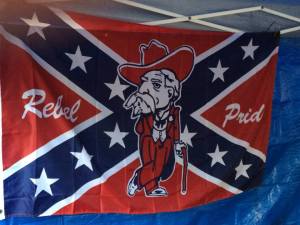
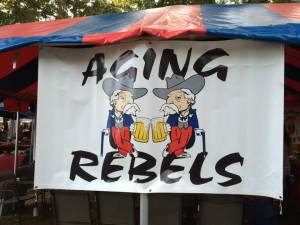
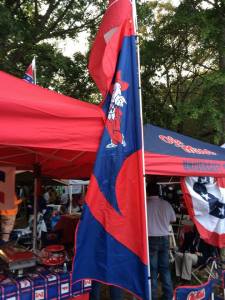
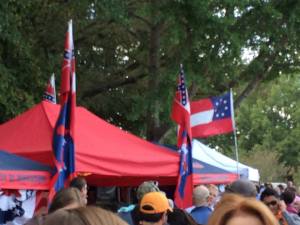
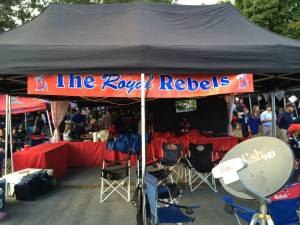
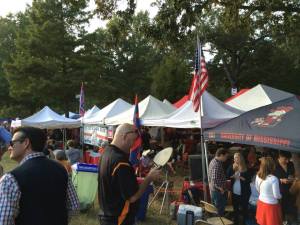
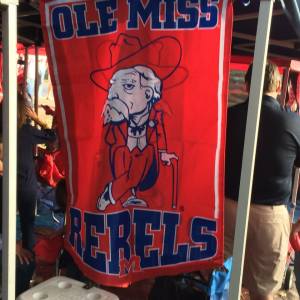
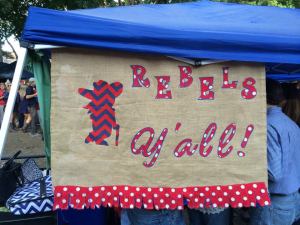
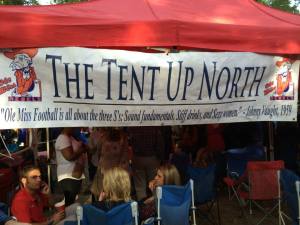



Not to mention the (ongoing) Confederate symbols at our university, Middle Tennessee State University. Even today, there an ongoing debate over the naming of Forrest Hall, and the Blue Raiders mascot is an evolution of the original mascot based on Forrest.
Elizabeth Catte scanned these documents from the Al Gore Center @ MTSU. There’s some incredible photos in there, such as Confederate flags at pep rallies and the old Nathan Bedford Forrest mascot: https://www.dropbox.com/sh/lprxnpuak2x16gs/AACzb-xXlWOMZVhDo6Rk6Xiea?dl=0
LikeLike
Important digging–I knew it was bad but not that bad. I wonder how MTSU stacks up with Vandy and UT?
LikeLike
Pingback: A Confederate on Campus: Nathan Bedford Forrest as MTSU’s Mascot | Sport in American History
Pingback: A Confederate on Campus: Nathan Bedford Forrest as MTSU’s Mascot | J. Howard, History